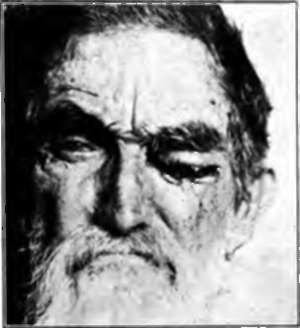Tumors of Eyelids
Description
This section is from the book "Skin Cancer", by Henry H. Hazen, A.B., M.D.. Also available from Amazon: Skin Cancer.
Tumors of Eyelids
Basal-celled growths are very prone to arise from the inner canthus of the eye, and to a slightly less extent from the outer canthus. Over thirty of Sequeira's cases had their origin in one of these locations. Tumors springing from other portions of the lids are comparatively infrequent, but nevertheless do occur, especially upon the lower lid. Bloodgood says that out of twenty-four epithelial tumors, benign and malignant, originating upon the lids, twelve were of the basal cellular variety. Hence it can readily be seen that the vast majority of malignant tumors arising from the lids are not of the prickle-celled type, and therefore are not especially malignant (Fig. 73).

Fig. 73.-Basal-celled cancer of eyelid that has invaded the orbit. (Author's collection).
McDonagh* has recently written an interesting article on the pathology of the skin from the eyelids and naso-facial grooves, and concludes his article as follows:
*Tumors affecting the orbito-facial and naso-faeial grooves are of epithelial origin, and atavistic of both the lower eyebrows and the specialized glands found in these regions in many of the mammalia. There is probably not an individual who will not show some trace of epithelial embryonic tissue (nevus) when a section is made from the skin of these grooves. All the tumors, from a simple hair-follicle growth to a rodent ulcer, are links in one chain, the former being the head or most mature, the latter the tail or most embryonic. As they are all links, the histological differences of one clinical entity are at once explained".
*McDonagh: Brit. Jour. Dermat.. 1912. xxiv. 291.
Clinically, these rodent ulcers usually spread rather slowly. As a general rule, the mucous membrane is spared for some little time, but eventually both it and the lachrymal sac are invaded and the eyeball destroyed, while the socket becomes deeply involved. In a few instances the tumor may run lengthwise along the upper or lower lid. Sequeira states that tumors at the outer canthus usually spread downward and early involve the bone, but such has not been the experience of the author.

Fig. 74.-Basal-celled cancer of the nose; a common location. (Poole's collection).
These growths are difficult to treat for two reasons-first, because it is difficult to satisfactorily repair a lid, and, secondly, because of the necessity of not injuring the eyeball. In the very early cases the writer usually cither excises or curettes and then tries the x-ray. In later cases either the x-ray or an operation founded on that originated by Sherwell should be used. In late cases the Sherwell operation* is undoubtedly the best. The majority of surgeons and dermatologists agree with these conclusions, even the most enthusiastic operators advising x-ray first. Caustic pastes must never be used, because of the proximity of the eye, and the inability to control their action.
Continue to:
Tags
bookdome.com, books, online, free, old, antique, new, read, browse, download
